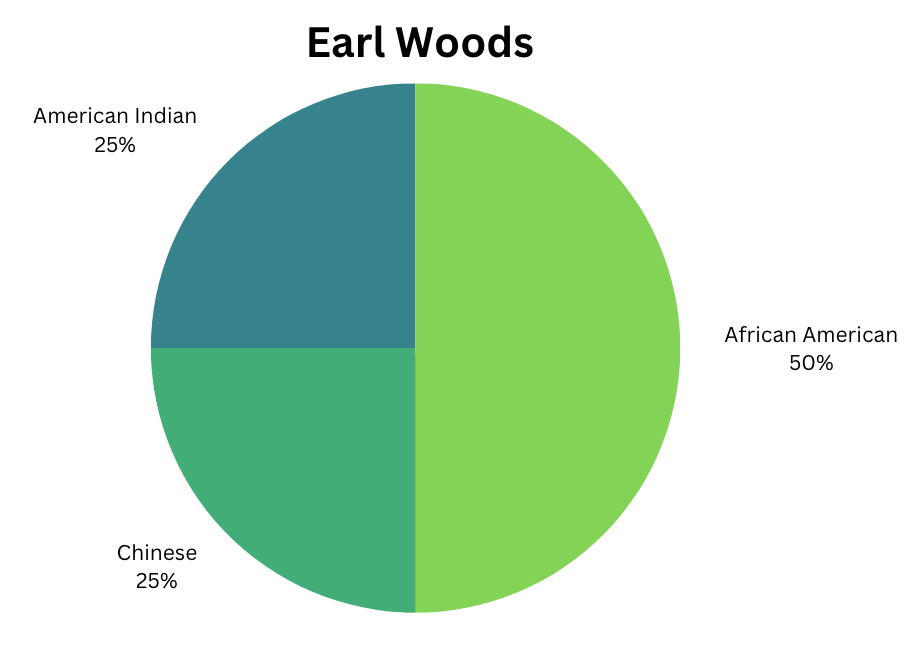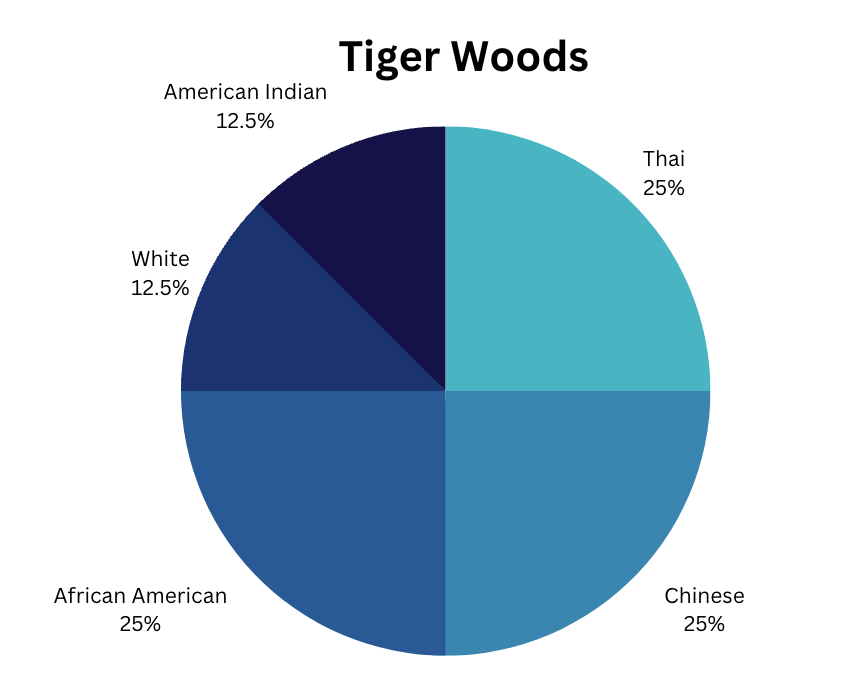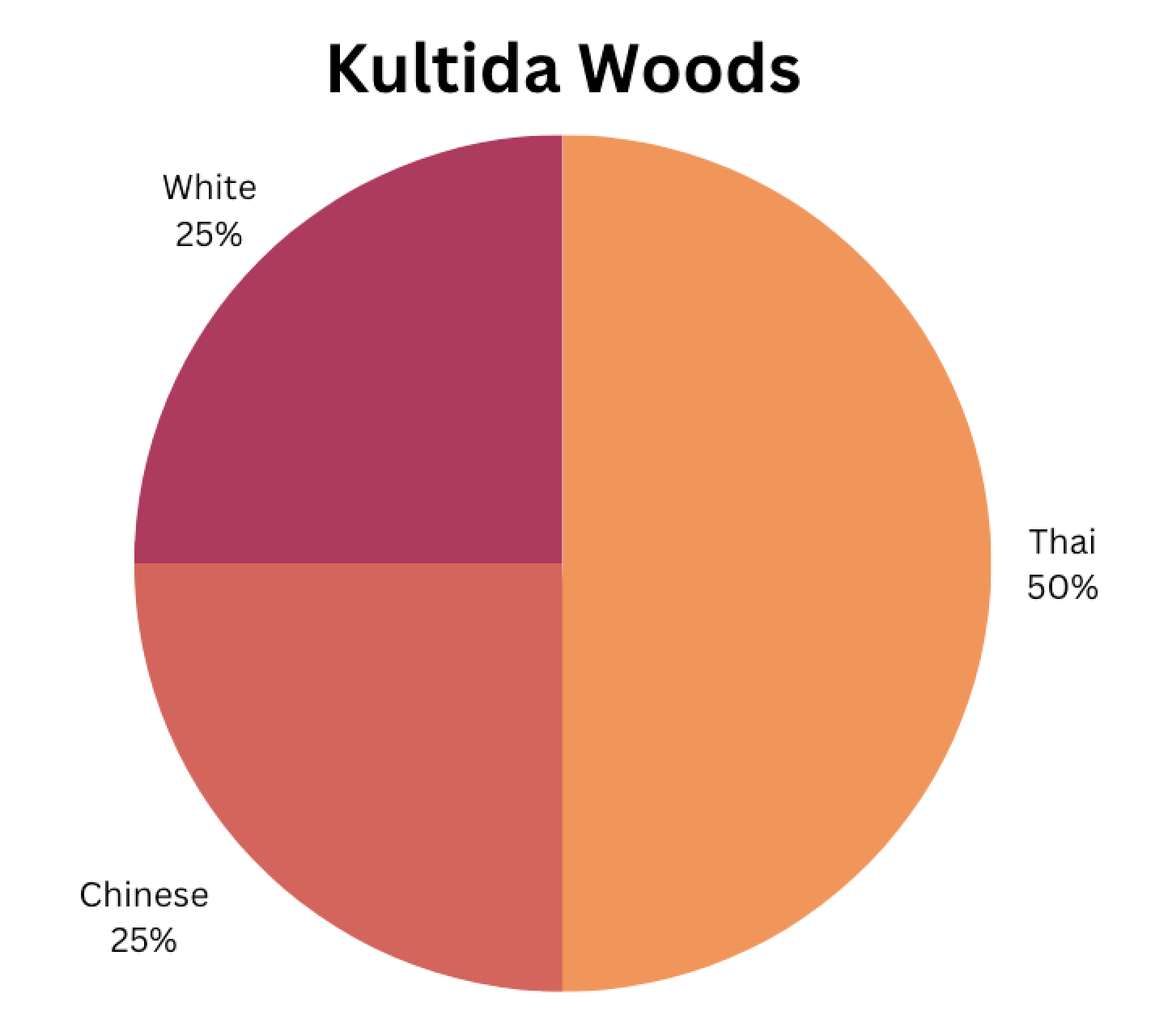Tiger Woods and Earl Woods at the USGA Junior Amateur Championships, 1991.
Rick Dole/Getty
Sensationalized Since Childhood
The ways in which Tiger presented himself to the media especially
early on in his career is heavily influenced by Earl Woods.
During his childhood, Earl aimed to separate Tiger's image from
the normal perception of black golfers, emphasizing Tiger's
privileged upbringing and exceptional talent in a feature spread
in Ebony, "this is one of the first Black golfers with natural
skills whose parents have the means to get pro instructions that
even exceed those afforded to Jack Nicklaus in his formative years." 5
Earl's portrayal of Tiger's exceptionalism in his early years
immediately attracted the golf world, a world that hoped to find
a symbol of racial progress in the eyes of post-racial America.
Along with the great amount of media attention in Tiger's life, HBO Max's
Tiger documentary series claims that Earl put an immense amount of pressure
on Tiger to become a hero for the black community and likened his potential
accomplishments to be on par with the historical narrative of black civil rights.
"Tiger will do more than any other man in history to change the course of humanity,"
Earl said, "he'll be bigger than Gandhi and Buddha...He is the Chosen One". 6 Earl's
talks about Tiger's blackness laid the foundation for sensationalized focus of his
black identity but perhaps more importantly, set up the erasure of Tiger's multiracialism
in the mainstream media.
Tiger On the Show "That's Incredible"
The clip depicts a TV feature on Tiger woods as an incredible
golfer at five years-old. He has already become a media
sensation–when he was two, he appeared on "The Mike Douglas Show"
with his father. In the clip, the feature chooses to emphasize
Tiger's "knowledge of the game" and his strategy while a white
golf pro describes him as "an exceptional person." In accordance
to Ben Carrington's theories3
about the black athlete versus
the white athlete, stereotypical white descriptors praise the
young Tiger's intelligence over his natural athletic abilities,
showcasing the early development of Tiger's hard work and work
ethic since he started playing when he was one year old.
Earl's control over Tiger's image can also be seen, where in his interview
he reinforces these white descriptors by stressing Tiger's intelligence and work
ethic. Thus, he presents Tiger as a suitable little role model for portraying white
ideals that are admired in America.
The sequence where Tiger is practicing at a nice golf course surrounded by white
people plays up his middle-class status. His exceptional personality is stated so Tiger
is not infantilized like children his age, and it separates Tiger from stereotypical
black descriptors that evoke the image of black aggression.
Overall, Tiger's portrayal through white descriptors allows Earl and Tiger to cultivate
an image that appeals to white America while the constant attention towards Earl's insistence
about Tiger's potential racial impact on America allows white golfers to accept him more and
caters to their need for evidence of a post-racial America.
Tiger's Early Racial Stance
Influenced by his father's racial visions for his life and career, Tiger Woods publicly affirmed his identity as an African-American golfer and acknowledged the racism that was still present in golf and society at the time. At a young age, he knew that his presence in golf and the implications of his racial identity were significant to golf's racial history, but he believed that he would triumph over racism by succeeding through his individual achievements rather than directly confronting white supremacy in sports through words and actions. Tiger emphasizes his blackness to meet everyone's expectations for him to become the black trailblazer of his generation:
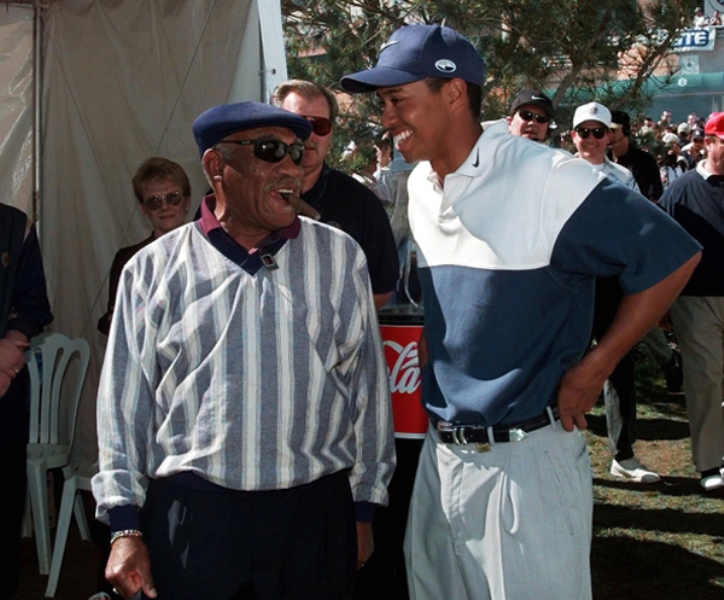
Tiger Woods and Charlie Sifford chat
Woods praised a tearful Elder and the other black
players who came before him: “I was the first one
to ever win [the Master's], but I wasn’t the pioneer,”
he said. “Charlie Sifford, Lee Elder, Ted Rhodes—those
are the guys who paved the way for me. I was thinking
about them last night and what they’ve done for me
and the game of golf."8

A Trans World Sport interview with Tiger Woods in November 1990 when Tiger was 14
"Since I'm black, I might even be bigger than Jack Nicklaus...I
might be even bigger than him, to the blacks. I might be sort
of like a Michael Jordan in basketball."6

Woods with his teammates during a collegiate tournament at Ohio State
"Every time I go to a major country club I can always feel it.
Always sense it. People always staring at me. 'What are you doing here?
You shouldn't be here.' When I go to Texas or Florida you always feel
it....And that's probably because that's where all the slavery was."6
Winning the 1997 Masters Tournament
Becoming the first black golfer to win the Masters in 1997 meant that there was extra emphasis on how different parts of Tiger's racial identity should be utilized. The tournament was a turning point in the way Tiger decided to represent his racial identity. Now that he has achieved national stardom, getting offered hefty sponsorships and appearing across the media, Tiger no longer aspired to become a golfing pioneer for the black community and transformed himself into a brand.
The Oprah Winfrey Show: "Cablinasian"
"Every time I go to a major country club I can always
feel it. Always sense it. People always staring at me.
'What are you doing here? You shouldn't be here.' When
I go to Texas or Florida you always feel it....And
that's probably because that's where all the slavery was."
Pete McDaniel, a Woods family friend, claims that as Tiger
became mega-rich and received many endorsements, this allowed
him to push back against Earl and assume control over his image.
"Tiger didn't want to be a messiah...Tiger didn't see himself
as the unifying force, that was Earl's dream. [Earl] didn't
realize the pressure that was placed on Tiger."6
Tiger's interview garnered widespread support and criticism
across the country. People who supported him argued that he should
be able to identify as multiracial and affirm all parts of his racial
identity.
Critics, however, disparaged Tiger for not asserting his blackness
since he passes as a black man in America, and considered his comment
"a weak, immature, and even selfish response to classic white racism.5
After the proclamation of his multiracial identity, Tiger would not
reaffirm a strong stance on multiracialism or his blackness and would
choose to remain apolitical and speak little on his race for fear of
backlash and interference with "the economics of his position"– "fan appeal,
endorsements, public appearances, the reception of his peers, and the golf
establishment, all challenge him to accept its culture."5
America's Colorblindness and Post Racial America
Earl's heavy media presence along with his mother Tida's minimal presence
in the media contributed to the carving of Tiger's early affirmations of
his blackness. Since Asian golfers mainly came from foreign countries and
were not of American nationalities, the media felt that it was easier to
focus strictly on the African-American part of his identity given America's
racial history with the black community. Woods's Asian and Native-American
heritage are not presented as distinct, equally-important parts of his identity
but are grouped together into a collective representation of Tiger's
multiracialism.
White America utilizes different parts of his multiracial identity when they
best suit their narratives of colorblindness and of a post-racial America. When
he is compared to black NBA players, Tiger Woods is considered a "breath of fresh
air"–a statement that demonizes representations of African-American NBA players
who embody the tropes of the "black athlete" in terms of aggression and savagery.4
Through his blackness, Woods is portrayed as a black man upholding White American
ideals that should be treated as the moral standard for black athletes, especially
for black basketball players that are charged with routinely violating national core
values. At the same time, his multiracialism is used to denounce the African-American
community for deviating from the familial and national traditional culture.4
In a study2 done by Andrew Billings from Clemson University, he wanted to determine how
implicit racial biases of sports commentators are demonstrated in tournament coverage of
Tiger Woods. Reviewing footage from the four major golf tournaments (Masters, US Open,
British Open, and PGA Championship) during the 2001 PGA season, Billings pinpointed
the common descriptor words used to describe Tiger's tournament play and compared
them to descriptors for other players in the field. Based on the results, Billings
concluded that when Tiger was playing well, his success was mostly attributed to his
experience, while in contrast, othe golfers were more likely to succeed because of
perceived athletic skill and composure. Conversely, when Tiger is playing poorly,
his failure is blamed on his lack of composure, frustration, and loss of concentration
significantly more than other golfers. The study demonstrates that Woods exhibits
stereotypes of both white and black athletes: when Woods is successful, the commentary
does not use traditional Black stereotypes. However, when Woods is failing, his struggles
are portrayed using black stereotypes, where his emotional intelligence and composure is
questioned.
Woods's representation in broadcasting reveals how his performance is racialized to allow white
America's to claim his successes whenever it can while separating his failings from his white image
and finding ways to blame his blackness for the parts of him America doesn't want to see. The back
and forth shift between the black and white binaries of Tiger's representation also conflicts with
the utilization of his multiracialism to further promote America's colorblindness. Woods' multiracialism
is celebrated as an achievement of America's acceptance of a multicultural melting pot4, where
all races and cultures are supposedly given the opportunities to reach the same levels of
socioeconomic standing as everyone else. America's colorblindness causes the country to assign
itself a privileged and morally superior position. As Gary Smith, senior writer at Sports
Illustrated, explains when commentating on Tiger's success in American culture, "it was
like White America patting itself on the back. Look, this is the promise that America makes.
That anyone can use the tools that this country offers and make it to the top regardless of
race, color, creed."6
Due to the backlash and the controversy caused by the "Cablinasian" interview, Tiger keeps a tight
lip around issues of race but when experiencing racial discrimination himself, he has attempted to
respond to these incidents in a manner that would please the public, but each decision he makes is
heavily scrutinized regardless of how he responded:
The Case of Fuzzy Zoeller
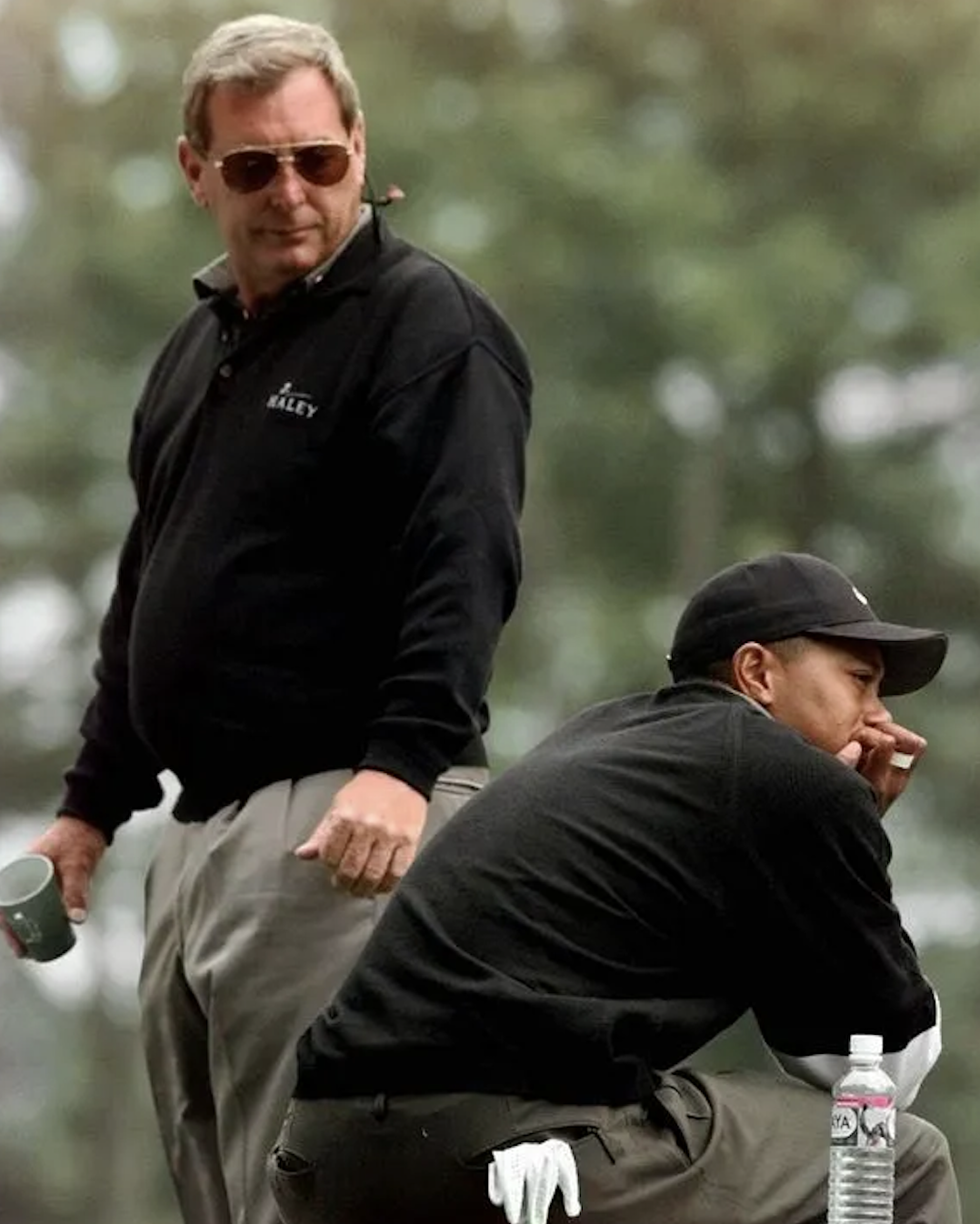
In 1997, fellow PGA tour player Fuzzy Zoeller was
asked about his thoughts on Tiger after completing
his round at the Masters, saying:
"That little boy is driving well and he's putting well.
He's doing everything it takes to win. So you know what you
guys do when he gets in here? You pat him on the back and
say congratulations and enjoy it and tell him not to serve
fried chicken next year....Or collard greens or whatever
the hell they serve." 8
While the backlash against Zoeller's comment was strong, Woods
offered no comment on his "racial joke" that Zoeller claimed to
make. Many used the incident to criticize his Woods's decision
to not affirm his blackness during the "Cablinasian" interview,
arguing that Zoeller's comment is evidence that Tiger is seen by
the world as a black man, and despite Tiger's multiracialism,
his experiences racism as a black man. Tiger's lack of response
to the incident was seen as him distancing himself from his
blackness and conversations about the black experience in
America.
On the contrary, others also criticized Woodss silence on the
issue because they claimed that he should've defended his fellow
player and not left him out to dry or his "harmless joke." The
thinly-veiled racism underlying these criticisms adhere to the
colorblind narratives of golf–these critics believed that because
there is integration in golf and that there is no blatant forms
of racism in present-day golf, there is no prevalent racist issues
that need to be addressed anymore, so they overlook the incident
or avoid conversations about the racism still entrenched on
tour to uphold a post-racial vision of America.
The Cablinasian interview scared Woods into silence about racial
issues, with many people believing that Tiger doesn't contribute anything
meaningful to racial discussions, but now Woods faced harsh backlash for
his silence on Zoeller's comment and for not attempting to put out a statement
addressing the PGA tour's racial issues.
The Kelly Tilghman Controversy

In early 2008, Golf Channel anchor Kelly Tilghman
joked that other players should "lynch" Woods in a
"back alley" if they hoped to win tournaments.
In this instance, Tiger Woods decided to quickly
release a statement, but instead of condemning Tilghman
for her racism, he called her comments a "non-issue"
and said that he knew there was "unequivocally...there
was no ill intent", in an effort to appease those who
believe in golf's colorblind narrative.8
Though he took a different approach to handle this
incident, his response is consistent with his pattern
of avoiding the polarized racial minefield of golf.
It also shows that any statement that Tiger makes will
likely set off new controversies, whether if he's being
criticized by colorblind America for taking a hard
stance on racial issues or being criticized by the black
community for perpetuating a false notion that progress
in golf, and by extension America, is complete and
no more action is needed.
If golf, considered one of America's most white and elitist
sports has dealt with its segregation, has a variety of professional
black players, and has a black man dominating a traditionally
white sport, is there a need to do more in America? This attitude
echoes the post-racial fantasies of Americans who boast about
the country's moral superiority. To them, America's ideals
of freedom, democracy, and liberty as expressed through the
opportunity given to Woods to have a successful golfing career
due to America's benevolence towards reconciling with someone
of Tiger's ethnicity to be on the tour.
Thus, Tiger portrays a racial image consistent with golf's elitist
history and beneficial for its desire for a suitable symbol of racial
progress.
The Nike Ads: Reconstructing Tiger's Racial Identity
An important example of the manipulation of Tiger's racial image for certain needs is Nike's role in taking advantage of the racial issues surrounding Tiger's racial identity to project an aesthetic that it trail blazes, represents American ideals, and appeals to different communities. This meant overemphasizing on Tiger's blackness, disregarding the fact that he is part white, and erasing the parts of his identity, the Asian and Native American aspects, that don't align with the message Nike wants to get across. For Tiger, conversations about race and his blackness were only used to help his brand, not directly confront racial issues in America.
"I Am Tiger Woods"
As the first Tiger Woods TV campaign, "I am Tiger Woods" utilizes
Tiger's multiracialism to present him as the "new face of America".4
Including a diverse set of children meant to represent Tiger's
African-American, Asian-American, and Caucasian heritage, the commercial
acts as a celebration of America's multiculturalism and racial progress.
Here, the portrayal of Tiger's multiracialism acts as evidence of a reformed
America that strays from its long history of racial discrimination. The clips
of different children holding golf clubs and bags, walking golf courses, and
hitting balls symbolizes what Woods's arrival on the PGA Tour means as a watershed
moment: Woods is an inspiration to the next wave of golfers and people envision
that the future golf tour will encompass a utopian-esque variety of different races
and hold greater diversity among its players.
Golf is characterized by the Nike commercial as having been democratized and a game
for the people, where children of any race or class can have access to the sport. However,
Tiger's own background contradicts this narrative because he became successful due to his
middle-class upbringing, where he had access to private country clubs, golf instruction,
and quality equipment that all can't be afforded by anyone. But because Woods attracted
millions of new fans to the PGA, especially many non-white fans, Nike attempts to connect
to this new target audience while gratifying white America's vision of the future generation.
Transcript: (*apologies, this was video with the best resolution I found)
"Hello World"
"I shot in the 70s when I was 8."
"I shot in the 60s when I was 12."
"I won the U.S. Junior Amateur when I was 15."
"Hello World."
"I played in the Nissan Open when I was 16."
"Hello World."
"I won the U.S. Amateur when I was 18."
"I played in the Master's when I was 19."
"I am the only man to win three consecutive U.S. Amateur titles."
"Hello World."
"There are still courses in the U.S. I am not allowed to play because of the color of my skin."
"Hello World."
"I've heard I'm not ready for you."
"Are you ready for me?"
"Hello World"
Widely considered Tiger's most controversial ad campaign,
Nike's "Hello World" commercial received much backlash
for Nike's opportunistic politics in playing the "race card".4
Cole and Andrews define race-carding as:
"a primary and explicit expression of the regulatory logic
that governs discourses around race in the USA...it implies that
the introduction of racial divisions is inappropriate and unfair.
Moreover, it implies that consciousness of race is itself an
obstacle to racial equality." 4
Nike's campaign strategy of race-carding was perceived by critics
as sidestepping critical reflection on national politics and instead,
capitalizing on racial narratives that white America loves to see–racial
progress being made at the center of sports.
In their attempts to reconcile with the growing numbers of non-white
people in America and their increased participation and representation
in sports, there was a fear that white people would soon become the new
minority and lose the ability to control racial power dynamics. Therefore,
Nike exploits this fear by aligning Tiger to American ideals of individualism,
colorblind meritocracy, masculinity, and proper citizenship. At a time
where increasing racial polarization, white America found a sense of
intimacy, pride, and reassurance in Tiger's image.
Along with the "I Am Tiger Woods" campaign, the commercial also characterized
Tiger as "innocent, pure, and virtuous" 4, a victim of undeserving blatant racism
that most White Americans concede is enough to take action against. Illustrating
Tiger as a victim in turn characterizes him as an apolitical figure that doesn't
offend anyone with confrontational politics. Victimizing Woods gives Americans an
"underdog" figure to root for while simultaneously feeding into the superiority
complex associated with America's post-racial fantasies, where whites view
non-whites as a charitable cause and patronizing them.
Tiger Woods's perceived activism was authorized by a nation linked to "media,
family, and consumption" and gave people what they wanted to see.This "familiar"
and "heroic" narrative, "in which consumers participate in", was manufactured
"against the backdrop of an exceptional experience." 4
Nike focused on Tiger's blackness to tell a sensationalized racial storyline
akin to Jackie Robinson's, giving Americans the means to change or rewrite America's
black racial history on their own terms, through a white perspective, ignoring the
actual struggles of the community.
How Does The Portrayal of Tiger's Racial Identity Connect to Larger Themes of American Values and Consumerism?
Early on, Tiger Woods, with the influence of his father, sought to be accepted by golf's establishment while
striving to enact social change on a broad scale. For the beginning of Tiger's career, there was a tension
between creating the illusion of racial progress in golf by emphasizing Tiger's blackness in the media and
using Woods as a representative of a minority figure aligned with white ideals. Tiger's multiracialism
became a tool to propagate a narrative supporting America's post-racialism and redirecting conversations
away from addressing deeper racial issues underlying American society.
Everyone put high expectations on Tiger to become golf's spokesperson for the new wave of racial progressivism
within the sport but the amount of pressure that he faced for every decision he made caused him to step back from
the conversation as a whole. This brings into question whether Tiger should be obligated to address golf's racial
issues or if people have a right to look to him to enact social change and expect him to present his life and
career in the name of progress.
Tiger's success as a brand depends on the economics of a system (the golf industry) that relies on its status
and symbol of white prestige to encourage the consumption of media, merchandise, etc. from its main consumers–wealthy
or middle-class people who can afford to play and watch golf. The actions (or lack thereof) that Tiger takes towards
confronting serious racial issues in golf impacts his image among the industry's target consumers which affects the
amount of wealth and recognition he receives from brand deals, public appearances, and fans. Indeed, Tiger has chosen
to protect the socioeconomic landscape of the sport for his own while sacrificing respect from the communities
represented through his multiracial identity.
